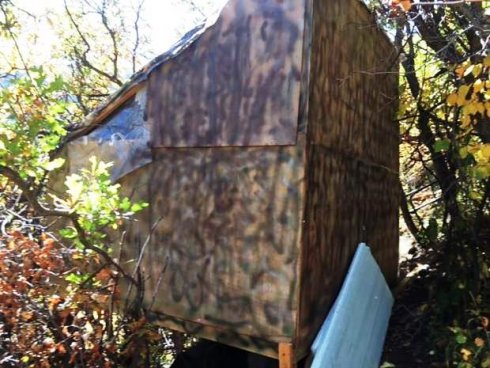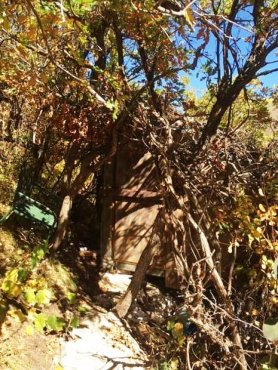The James Hogue Shack (Aspen Mountain)
5. See this May 24, 2017 article by M. John Fayhee, "The End of the Run for Con Artist James Hogue. From a podium finish in Vail to a plywood shack on Aspen Mountain, the curious conclusion of a gifted athlete-turned-grifter’s romance with Colorado mountain towns." Published in the Summer 2017 issue of Aspen Sojourner. https://www.aspensojo.com/articles/2017/5/24/the-end-of-the-run-for-con-artist-james-hogue
6. See the January 21, 2018 article by M. John Fayhee below the two photos immediately below.
___________________________________________________________________________
"It has been almost exactly a year since I first met James Hogue. He was then a resident of the Pitkin County Jail, having been arrested in November 2016 and charged with two felonies — possession of burglary tools and theft of items (from ski gear, to construction materials and tools, to designer clothing, to water bottles) valued between $2,000 and $5,000 — and a misdemeanor, obstructing a peace officer.
Like most people I have since talked to about James Hogue, when his name was first brought to my attention by Cindy Hirschfeld, editor of Aspen Sojourner, it rang a bell, but not a loud one. I had to be reminded that it was Hogue who had been discovered living in a shack he had constructed illegally on the side of Aspen Mountain, in the middle of the 13-acre Barbee Open Space parcel, almost within sight of Lift 1A.
When Aspen open space rangers, along with a police officer, visited the shack after its discovery by some local workers who had had some tools stolen, Hogue was at home, but he escaped through a back window and fled. The rangers and the cop peered into the window of the shack, which they could not access without a warrant, even though it was located on public property. What they saw amazed them. The shack was filled to brimming with high-end outdoor gear and clothing.
Next time law enforcement came a-callin’, with the intent of evicting the tenant, who they had not yet identified, the shack had been cleaned out and abandoned. Over the course of a week, it was disassembled by open space rangers.
Not long thereafter, following a series of thefts from proximate construction sites, Hogue was arrested. His vehicle, a 2005 green Nissan Xterra, which had been illegally parked in an employees-only Aspen Skiing Co. lot, was, with Hogue’s consent, searched. It contained the contents of Hogue’s shack, most of which police determined had been stolen. The name-brand items, many of which still had price tags attached, were returned to the stores from which they had been heisted. But much of Hogue’s stash, which cops assumed was likewise illegally obtained, was left in the Xterra, its provenance impossible to establish. The Xterra, filled with 18 duffel bags containing clothing, bike gear, camera gear and a couple laptops, was taken to the police impound lot near the county landfill.
That Xterra now sits in my driveway, it’s contents take up a sizable portion of my basement.
Runner gets caught
Hirschfeld asked if I would be interested in penning a magazine piece on Hogue.
I was. Very.
I soon learned that, not only was Hogue’s criminal history extensive, but that history had once risen to the level of legend.
In a nutshell: In the mid-’80s, Hogue gained national notoriety for a pair of high-profile impersonations. In September 1985, a month before his 26th birthday, he had enrolled in Palo Alto High School in California and passed himself off as a 16-year-old endurance runner.
He was caught after an enterprising local sportswriter began an investigation.
A few years later, after having invented a convoluted backstory, Hogue fraudulently enrolled in Princeton University and ran track for the Tigers after having been given a full-ride scholarship.
He was outed at a track meet by someone who had been his classmate at Palo Alto High School.
His impersonations resulted in numerous magazine and newspaper articles, as well as a book and an HBO documentary.
The life of Hogue, who had once run a sub-4-minute mile, had been defined by criminal activity, arrests and incarceration. He had gone to prison in Utah for the theft of bike parts and tools. In 1992, he was convicted of stealing precious jewels and gemstones from the Harvard Mineralogical & Geological Museum, where he worked as a security guard after being released from prison after his Princeton impersonation.
He also had arrests in Aspen — in 1993 for stealing food and Rogaine from a grocery store and in 1997 for bicycle theft. Add to that an arrest for grand larceny in Telluride, where Hogue lived for a short time in the mid-2000s.
By the time Hogue faced Pitkin County District Court Judge Christopher Seldin last March, he had at least five felony convictions under his belt. As a result, Seldin sentenced Hogue to six years in prison, despite a plea agreement that called for a three-year sentence. Given his extensive criminal history, Seldin enhanced Hogue’s punishment. It could have been worse. Hogue could have been sentenced to as long as 18 years as a habitual offender.
Shortly after signing on to write the story for Aspen Sojourner, I made an effort to visit Hogue in the Aspen jail. I had been forewarned that he was very standoffish and did not countenance interaction with members of the media. I wrote him a note introducing myself and outlining my intent. I placed that note inside a copy of a book I had written titled, “Smoke Signals,” in hopes that Hogue, known to be voracious reader, would grant me an audience. I dropped the package off at jail, expecting no reply. Much to my surprise, however, a week later, Hogue called and agreed to meet with the unambiguous stipulation that I not interview him. He would be willing to talk, but not to be grilled.
This marked my virgin experience visiting someone behind bars. It was awkward on several levels, not the least of which being that we had to talk over phones with a pane of glass between us.
I visited Hogue in the county jail a total of six times for one hour each. The first four of those visits occurred before he was sentenced; the last two occurred after Seldin had ruled but before Hogue was shipped out.
During the first four visits, our conversation rambled. We talked about books, hiking, traveling, linguistics, the sociology of the Roaring Fork Valley and life in the local jail. Whenever my journalistic inclinations overcame the no-interview deal I had made with Hogue — such as the time I asked why he had chosen to build his shack where he did — he glanced downward, crossed his arms and said gruffly, “I don’t remember.”
For the most part, though, Hogue looked me in the eye when we talked. This was something of a surprise, as almost everything I had read and heard about him indicated that he rarely made eye contact while conversing, even with people he knew well.
Maybe I was reading too much into that one personality trait, but it seemed that staring me straight in the viewpods while we conversed was a sign he felt comfortable with me. Or that he was sizing me up.
All in all, our visits were convivial enough.
For sale by owner
After he was sentenced, however, Hogue’s demeanor changed. He was agitated and clearly pissed off. He spewed vitriol, mostly toward police in general and the Aspen Police Department specifically. He accused Detective Jeff Fain of lying to him and stealing his stuff, which, I gently reminded him, he himself had stolen. Almost $17,000 in cash had been found in that green Xterra and Hogue was convinced that the cops who had searched his vehicle had absconded with the money. (Fain handed Hogue a cashier’s check for the full amount just before my last visit with him.)
Hogue went on a rant about what he perceived as epidemic police corruption and how, when a cop drives so much as five miles an hour over the speed limit, he or she should be forced to resign. He raged that a local officer who had been suspected of drunk driving was getting sympathetic treatment from the judiciary because he carried a badge. (The cop in question was eventually terminated and recently was given probation on a drunk-with-a-weapon charge.) He railed about what he perceived as the preferential treatment by the Aspen PD of misbehaving celebrities.
The jail employees did not know when the Colorado Department of Corrections people would arrive to take Hogue away, and, even if they did, they do not share that information with the public in case anyone is inclined to organize an escape attempt. They said Hogue might be gone the next day or in a month.
In what turned out to be our last visit at the Pitkin County Jail, I asked Hogue in passing what was going to be done with his Xterra. He said he had been trying to find someone to take it off his hands because, otherwise, he was certain his captors would steal it. Being in the market for a daily driver but never having seen the vehicle, much less driven it, I offered to buy his ride. We negotiated a price and, with the assistance of the cops Hogue hated so much, we completed the out-of-the-ordinary transaction.
On a blustery April day, the very officer who had arrested Hogue six months prior met me at the impound lot and handed me the keys to the vehicle, which was still full of all of Hogue’s worldly possessions. The Xterra had license plates two years expired and all of doors were sealed tight with evidence tape that I came to learn is almost impossible to remove. My intent was to beeline to the DMV office in Aspen to make the Xterra legal. I wondered how far I would make it before getting pulled over. In less than half a mile, a bank of flashing lights appeared in my rearview mirror.
The next time I went by the jail, Hogue was gone.
The gate and the thud
I wrote Hogue a letter at the Trinidad Correctional Facility asking if he would be interested in having me visit him. He did not respond. Undeterred (or unable to take a hint) and after filling out a lengthy application form, I became the one and only person on the visitor list for a man who has been featured in The New Yorker and on HBO.
On my way between Aspen and my home in New Mexico, I pulled into the Trinidad Correctional Facility. It was July 4 and the parking lot was mostly empty. Before me was an expansive, verdant exercise yard that opened to a stunning view of the Spanish Peaks and the Sangre de Cristo Range. Ignore the double row of fencing and the fact that everyone on the other side was attired in green prison garb and it could have been an urban park.
I went through one razor-wire-topped gate, which closed behind me with a kind of thud that’s hard to ignore.
Then another gate and another thud.
Then a thick metal door into the entry room. There are lockers like you see in bus stations into which you must place all your possessions. The only thing you are allowed to bring in is a stash of quarters, because there are vending machines in the visitation room. I got thoroughly searched before going through yet another thick metal door.
Hogue was the only one sitting in a room that had a shielded guard station at one end, a series of shiny new vending machines at the other end and card tables and chairs in between. We shook hands. It was the first time since I made his acquaintance six months prior that we had made physical contact. He seemed far more relaxed than he had been in the Aspen jail.
We talked for three hours about his Xterra, about various hikes, about books. He told me a bit about his life at the Trinidad Correctional Facility, but not much. He had begun running again but did not have shoes. So, he was going around the track in boots. He was, like all the other inmates at this minimum-security prison, allowed to stay in the yard as long as nine hours a day.
Twice during my visit, guards came through for a head count. They were extremely courteous, referring to him as “Mister Hogue.”
It would be inaccurate to call the place “pleasant,” but it did not come across like a dismal, dungeon-esque hell hole either.
As I prepared to hit the road in the Xterra Hogue once owned, I asked if I might visit him again. “I guess that would be alright,” he said. It was hard to read the tone with which those words were uttered.
Kitchen table issues
I paid Hogue a second visit the day after Thanksgiving. This time, the visitors’ lounge was full. It was a strange scene, as families gathered to share the tail-end of the holiday. There were children, elderly parents and wives — all playing catch-up on the kind of domestic business usually conducted around a dining-room table. I had trouble concentrating on my conversation with Hogue, so mesmerized was I by the interaction between ordinary-looking people and their incarcerated loved ones.
Hogue had been working out intensely, lifting weights and running seven days a week. He looked tanned and fit. He opened up a bit more about prison life, describing his pod and his daily routine. He can pretty much get up when he wants. Meal schedules are pretty loose. He has made a few friends.
I wanted to ask about his attempts to, quote-unquote, better himself. When he was sentenced in Pitkin County District Court, there was discussion among the judge, the prosecutor and Hogue’s defense attorney about his need to therapeutically address his kleptomania, which is only starting to be seen as a diagnosable and treatable form of compulsive behavior, akin to gambling addiction. A letter read during the sentencing hearing from writer Peter Hessler, who ran track with Hogue at Princeton, indicated that Hogue understood he needed help to address his penchant for stealing. I do not know if the Trinidad Correctional Facility has in-house expertise in such things but I did not ask Hogue about that. I still feel constrained by our non-interview ground rules.
We visited for three hours again. Time flew. Before I left, Hogue asked what compelled me to visit him. I said, “I like you.” This time, he smiled ever so slightly.
Recidivism
Truth be told, I suspect the reason I continue to visit James Hogue runs deep down into my DNA. I know it sounds melodramatic, but, pretty much from age zero through my high school years, I was headed down a dark and predictable path toward long-term incarceration. I’ll leave it at that. But, somehow, I broke from that path. I didn’t become a saint, but neither did I become a six-time convicted felon. I am curious what made Hogue go his way and me go mine. By all accounts, he was a model citizen as a youth, very much unlike me. He is far smarter than I am. He is more educated and better read.
Yet …
Hogue and I have talked about, when he gets out, sharing the one compassion we hold in common: hiking. We have pondered a couple routes along the Arizona Trail, which I hiked end-to-end in 1997.
He is eligible for parole in October 2019, when he is 60 years old. No guarantee he’ll be granted his release at that time and, even if he is, there are still some unresolved charges pending against him in Boulder County. Even if he finds himself walking free in the foreseeable future, I have little doubt he will eventually end up back behind bars. I don’t think he will be able to break away from the illegal behavior that has defined his entire adult life. I hope I am wrong, but I think evidence backs me up.
On the day he walks free, even if only for a short time, I intend to meet him at the prison gate and hand him back the keys to his green 2005 Nissan Xterra, in which I will have piled all his gear.
At that point, I have no idea which direction he will choose to drive.
It may very well be back to Aspen."
The photo below was a part of this article. Click on the image to enlarge.


